Following Ottawa's lead, we can take five simple steps that will make Hamilton a more bikeable and liveable city.
By Justin Jones
Published May 24, 2013
I was fortunate enough to pay a visit to our nation's capital recently on a work trip - and I was absolutely blown away by how great Ottawa is for cycling. The really amazing thing, to my mind, was how many of the things they had done were so simple and so applicable to our fair city. So first, let's break down some of the things that Hamilton is doing to improve cycling in this city.
1) We're installing new infrastructure at a pretty decent pace. We're moving forward on completing our network of cycling infrastructure much faster than many of our neighbouring municipalities, and, to that end, faster than most jurisdictions in the province.
2) We have great pathways and trails. Much like in Ottawa, we have access to some great waterfront trails, trails that run on old rail lines, and other places where recreational and, to a lesser extent, commuter cycling is beautiful and thoroughly enjoyable.
3) We've installed some amazing cycling infrastructure lately. The protected bike and pedestrian lanes on the bridges over King and Main Street, the contra-flow bike lanes on both those streets and the terribly under-utilized bike box at Aberdeen and Studholme are all world-class pieces of cycling infrastructure.
Some, like the contra-flow lanes and the bike box, could use more signage, visibility and education about how they work, but they are still an important start.
Now on to the areas where we could really learn from Ottawa's example. When I was in Ottawa, I saw hundreds of cyclists riding around safely and legally. I only saw one person riding on the sidewalk, saw most cyclists stop at stop signs, and never once heard a car horn honked at a cyclist.
This kind of cycling culture - one where cyclists respect the rules of the road because they are given the space and respect they deserve while they're on them - doesn't just magically appear. It takes safe infrastructure, education for cyclists and drivers and the will to change a culture from one focused on using streets to move cars to one focused on using streets to move people.
So let's talk about how Ottawa has changed that conversation, and how we in Hamilton could learn from their example by incorporating these five simple changes.
Laurier Street in Ottawa is amazing. I almost fell over when I first saw it, walking away from the stench of corruption emanating from Parliament Hill. The bright green markings on the pavement delineate the bike lane where it passes through the intersection, providing visibility for the bike lane in the areas where the lane is not protected.
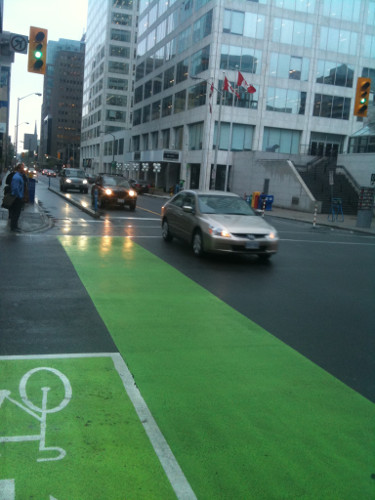
Intersection paint delineates the bike lane where it passes through the intersection
The protection for cyclists on Laurier is simple - just concrete blocks, no more than 4 inches high, with blue posts intermittently along their length, providing additional visibility.
If a car really wanted to get over the barrier, it would be no harder than mounting the curb, but that small protective measure is so significant in making cyclists feel safer. And when the route feels safer, more people use it.
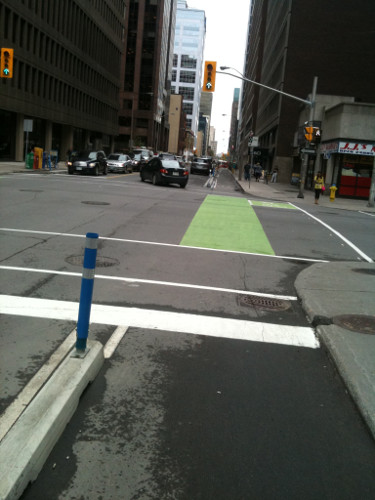
Protected bike lane
When you do that, you move beyond cyclists like me - who will ride basically anywhere in any traffic conditions - and open the streets up to less confident cyclists, to parents with trailers towing their kids, to seniors who ride at a nice leisurely pace.
It's an amazing phenomenon and, as I've learned through the Yes We Cannon campaign, it will happen here in Hamilton as well once safe infrastructure is built.
Of the over 200 statements that we've already sent to council, many of the signatories indicate that they would like to cycle more, but current road and infrastructure conditions do not make them feel safe or respected on the roads.
If we change this, I am confident that we will see an explosion in the number of cyclists we see on the roads in Hamilton, which also means less cars on the road, which means less traffic for drivers to deal with as well. It's a win-win scenario.
I really do commend Hamilton for the great steps they've taken towards making the city better for cyclists. A lot of new infrastructure has been built and more is on the way. The other side of the coin when it comes to infrastructure development, however, is putting bike infrastructure where people want to go.
Yes, side streets are nice to ride down when you're out for a leisurely ride, but if you want to bike to school, to work, to the grocery store and so on, you don't want to have to take a labyrinthine route through residential streets and four-way stops. You want to get to your destination quickly and efficiently.
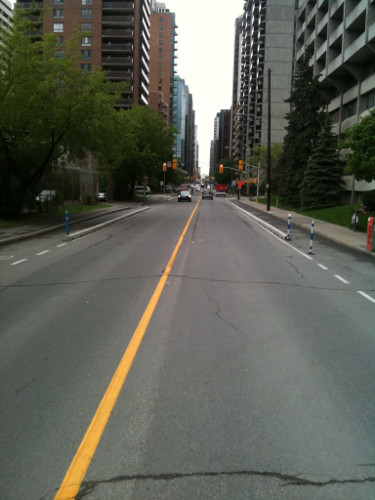
Laurier Street takes people east to west across Ottawa in safety and comfort - it would be amazing to have a similar route here in Hamilton!
So while bike lanes in Binbrook might be great for those long weekend rides, for commuter cyclists downtown they really don't mean much. This is why I feel that Cannon is such a perfect street to be converted into a cycling spine - because it connects people quickly, effectively and directly to where they want to go.
In Ottawa the number of straight-line routes across the city is amazing - and the cycling modal share clearly illustrates the impact of those routes on cycling uptake.
I'm going to go back to Laurier again, because it's amazing. While riding along Laurier, I saw the sign below, and had to stop to get a picture of it.
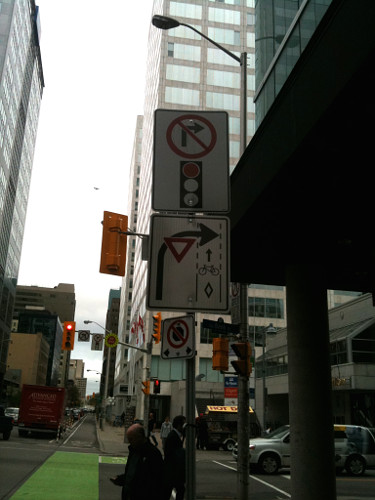
Yield sign for cyclists
Why did I have to stop? Because that one little sign represents a true commitment to keeping drivers aware of cyclists and keeping cyclists safe. It's a reminder to drivers that cyclists are there, and it also provides cyclists a little bit of assurance that they're being watched for.
The dreaded "right hook" - where a car makes a right hand turn immediately in front of you - is one of the scariest, and potentially deadliest, moments in a cyclists two-wheeled life.
Just that little reminder to cyclists and drivers to look out for one another - and to drivers to give cyclists the respect that they deserve on the roads - sends an unmistakeable message that, in Ottawa, cyclists are welcomed and respected.
In Hamilton, where we have an absolute glut of surface parking for cars, finding a place to lock your bike is often a daunting prospect. More often than not, I've locked my bike to parking meters, fences, road signs and even the occasional tree (although I REALLY hate doing that) simply because there is nowhere else to lock your bike. In Ottawa, on the other hand, I saw so many of these...
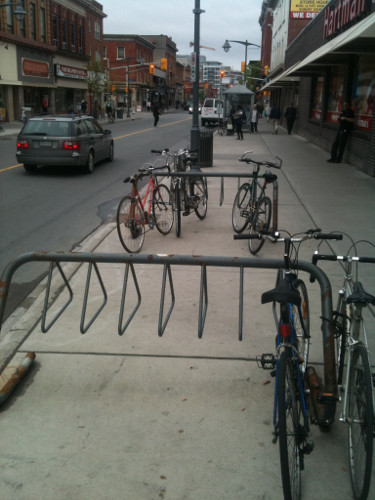
Big bike rack
And these...
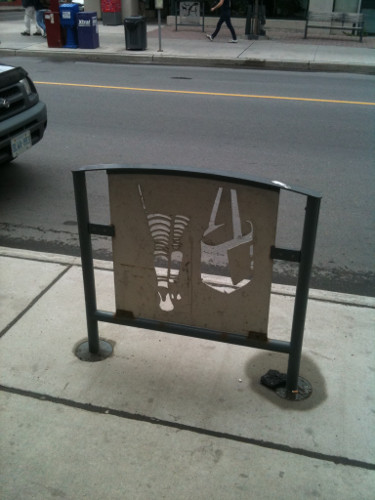
Art rack, empty
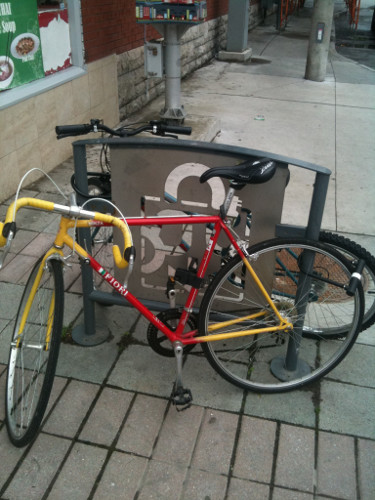
Art rack, full
...that it made my head spin.
The top image is a practical, low-cost, high capacity rack. I saw them on almost every corner of Bank Street and all over the downtown.
The lower image is a great example of how a Bike Rack can be a part of the streetscape - how it can incorporate art and practicality and provide people with a visible reminder that bikes matter.
As important as the practical aspects of bike parking are - people aren't going to ride their bikes around if there's nowhere safe and secure to lock them up, the same as you wouldn't park your car somewhere if you weren't allowed to lock it or remove the keys from the ignition - the messaging it sends is equally important.
Slapping up the odd low-cost, low-capacity bike rack sends a loud and clear message: cyclists are an afterthought. Not installing them at all sends an even stronger message: we didn't even consider cyclists.
By installing abundant bike racks all over the downtown, Ottawa has sent a different message to cyclists. They have told cyclists that they want them on their roads, in their neighbourhoods and in their shops. They've said that the security of one's bike - one's mode of transportation - is no less important than the security of a car.
This is one area where Hamilton can make significant progress without spending a ton of money - we need to start providing cyclists a place to park their vehicle the same as we provide them for drivers.
I love Bike Share. Love every single aspect of it. I think that the BIXI system, which they have in Ottawa, is amazing - those bikes are fun, practical and comfortable and provide occasional cyclists, people without the space to store a bike and tourists a great opportunity to have access to a bike. But in Ottawa, it's not the only game in town.
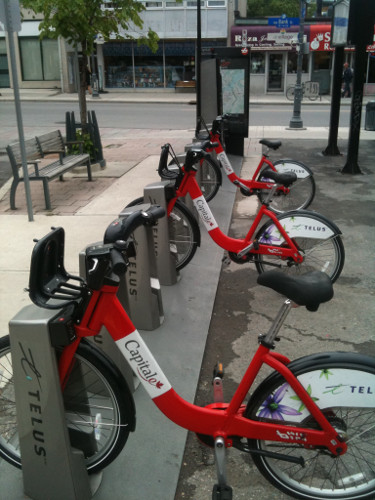
Ottawa BIXI
Right Bike is also spread out across some of the neighbourhoods in Ottawa, providing members with the chance to use a nice, practical cruiser bike whenever they need one. It's a great example of a smaller-scale, community based bike share, and while it might not work for all areas of Hamilton, it's certainly proving to be a successful model across other cities.
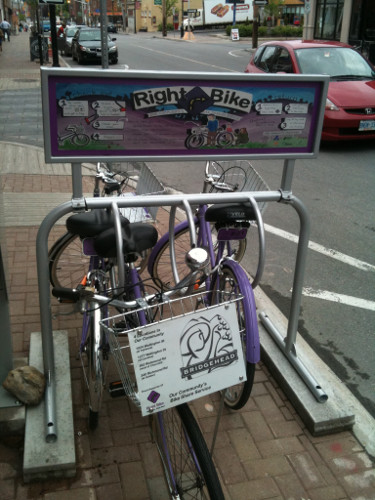
Ottawa Right Bike
Bike Share opens up the world of cycling to those who aren't sure if they want to commit to buying their own bike and to those who are just getting back into riding a bike. It's a great way to build a cycling culture in the City, and I'm so excited that council has approved it.
So now that it's been approved to go out for tender, let's get it done and really step up our game.
I admit that there are going to be challenges as we strive to become a more bikeable city. We've been so focused on cars for so long that it is going to take a real effort to make a significant change.
But if we really want to achieve our vision of a healthier, more prosperous Hamilton and if we truly want to be "the best place in Canada to raise a child", we have to start taking steps to make our city work for everyone.
These are five very affordable, very doable things that could be implemented in Hamilton by next year to make our city more cycle-friendly. (Of course, I still think that the most significant improvement we could make is putting Bike Lanes on Cannon Street.)
All that we need is the political will to make it clear to drivers and cyclists alike that Hamilton is a city where cyclists are considered, respected and welcomed. Let's get things moving in the right direction!
By Andy (anonymous) | Posted May 23, 2013 at 21:45:09
Wonderful post. As a relatively recent cyclist in Hamilton - having biked in Vancouver, Victoria, Ottawa and the San Francisco Bay Area - I am pretty dismayed. Hope the city is listening!
By jason (registered) | Posted May 23, 2013 at 22:32:17
Wow...I was in Ottawa 2 summers ago and NONE of this existed. Amazing what a tiny bit of vision and leadership will do.
Thx for posting.
By jason (registered) | Posted May 23, 2013 at 22:35:11
by the way, in Hamilton our wise staffers have decided that, unlike the rest of the world, we can't use green paint on the roads for lanes or bike boxes, or it will result in cyclists being run down like road kill everywhere else in the city without the green paint. Of course, this has happened in exactly zero cities, but hey, it's Hamilton. Any excuse to maintain the 50's vibe.
By ummm (anonymous) | Posted May 24, 2013 at 10:45:26 in reply to Comment 88915
Define "the rest of the world" Jason. As usual you prefer snark to facts. In Ontario, green paint as cycling pavement marking colour is not an approved treatment yet. It will be soon. The "wise staffer" you mention with such scorn might just be waiting for that level of approval.
By jason (registered) | Posted May 24, 2013 at 14:19:05 in reply to Comment 88930
Do a google image search of the term 'bike box'.
90% of the images are huge green boxes like we see in Ottawa. The ones with no green paint are hugely visible boxes like this:
http://www.blogto.com/upload/2010/10/201...
I can't find anywhere else calling this a legit bike box:
http://www.raisethehammer.org/static/ima...
So, by 'the rest of the world', I'm referring to every city on planet earth with photos of their bike boxes on the internet.
By Even Burlington (anonymous) | Posted May 23, 2013 at 23:43:20
Ottawa gets alternative transport --- how many other places can you skate to work in the winter?
That said, our powers that be don't need to travel so far to see some of these ideas in practice. Our at times maligned "suburban" neighbour to the west, Burlington, paints bike lanes across highway accesses and offer a variety of trails and cycling amenities that put the Hammer to shame (they've also started Car Free Sunday road closures to highlight options for urban roadways). This is especially sad when it was us, not them, that published Shifting Gears so many years ago.
By openstreets (anonymous) | Posted May 24, 2013 at 10:43:09 in reply to Comment 88921
www.openstreetshamilton.ca
Four years running.
http://cms.burlington.ca/Page4410.aspx
Burlington Cycling Master Plan, first published in 1997, refreshed in 2009.
By movedtohamilton (registered) | Posted May 24, 2013 at 09:19:16
In his post, Jason mentioned what a tiny bit of leadership and vision will do.
That is so hard to find in Hamilton. It is essential that we start organizing now for Election 2014, during which time we need to find councilor candidates with vision and leadership.
By matthewsweet (registered) | Posted May 24, 2013 at 14:04:19 in reply to Comment 88925
Agreed. Channeling the energy and passion for these issues into an organized political program, making cycling a vote-able issue etc, is the best way to ensure change that we want to see happen takes place.
By Fred Street (anonymous) | Posted May 24, 2013 at 12:04:19
I am encouraged by recent changes, even if they are tentative at this stage. Too often the perfect is the enemy of the good, and we have become conditioned to expect things to dissolve into farce. I applaud every gain. If our bravest dreams are to be realized, we need to reasset our common interests. On that count, it's important to bring more change-agents into city life and have them recognize the positive difference that even small, evidence-driven policies can have on the life of the city. The faster and more widely we can do so, the more we will ultimately benefit.
By matthewsweet (registered) | Posted May 24, 2013 at 14:20:07
Just my thoughts on a couple of points raised:
The bike box at Aberdeen and Studholme is underutilized because few cyclists coming off the rail trail crossing the 403 are likely to be turning left to access Longwood. For a pilot bike box location, better options are surely available. Perhaps left turning cyclists from Stone Church bike lanes onto Upper Paradise bike lanes? Not downtown but it would connect two cycling facilities.
The two way facility on King St across the 403 isn't "new", but rather is open again now that the bridge rehab by the MTO is complete. The City did complete enhancements to the west side of the lanes which are welcome additions and I think work very well (snow storage in the winter aside).
The Laurier cycle tracks in Ottawa are actually still a Pilot Project! (How upset would our cycling community get at that label being applied to an exciting project?) And Justin's point about build it and they will come holds true thus far. Ridership along Laurier has more than tripled since installation.
http://ottawa.ca/calendar/ottawa/citycou...
http://ottawa-laurier.visio-tools.com/
In the summer of 2011 I did a survey of bike parking in the area around Jackson Square and the GO Station. I may not have captured every rack or ring but I counted capacity for over 100 bicycles. Since that time, the City has installed tons of small post and ring bike parking throughout the downtown. None of the artistic type that you photographed, but an investment nonetheless. (I'm not convinced a lot of people know that those artistic bike racks are actually bike racks in fact.)
By jason (registered) | Posted May 24, 2013 at 17:55:44 in reply to Comment 88958
Great thoughts. I've noticed the same things as you. Even with the post/ring racks around Jackson there still isn't enough. I think we need a few corrals on King, Bay, James and York.
Bike box- definitely, it's a horrid location etc....
The two-way bike lanes from Dundurn to Westdale are perhaps our finest piece of urban cycling infrastructure. This week the project was completed with bollards and signage protecting the lanes from vehicle lanes all the way from Dundurn to Paradise. Would love to see bollards and narrow curb pieces installed beside our bike lanes wherever possible.
This is curb protection and bollards on Laurier:
By E Sernie (anonymous) | Posted May 24, 2013 at 22:17:59
Last February I was amazed at the changes made in Mexico City over the past year: many dedicated bike lanes with barriers separating the lanes from car lanes; a vast network of ecobici (Bike share), with fare links to public transit; the Sunday Cicloton -- the central six lanes of the Paseo de la Reforma closed to cars, and taken over by cyclists, skaters (bladers?), runners, and pedestrians! Even during the week, when cars were back on the Reforma, I felt safer as a pedestrian than I do when walking on Hamilton's major expressways, where drivers think they are at the Indianapolis speedway.
By Charles A-M (Ottawa) (anonymous) | Posted May 25, 2013 at 10:02:36
This is the important point that made the difference in Ottawa. The municipality won't do anything for cyclists unless the politicians direct them to, and the politicians won't do it unless it'll help get them [re-]elected. A lot of lobbying and dialogue with council candidates by Citizens for Safe Cycling (www.safecycling.ca) and other cycling advocacy groups helped to elect a pro-cycling council, and more importantly, helped to inform the returning councillors of how cycling is useful. Positive messages are important. Have a look through CfSC's web archives for some of the things they did back in 2010.
But there were other things that moved Ottawa forward, too. Our Cycling Plan was approved in 2008 after years of delay (the first transportation plan in Ottawa with a price tag attached), and a pro-segregated bike lane group lobbied hard behind the scenes, meeting individually with councillors, to get them to bundle in with the cycling plan approval a direction to staff to do a pilot east-west bike lane. That idea was acted on in 2010 with the initiation of the Laurier Avenue segregated bicycle lane pilot project which ends later this year (council will decide this summer what happens at the end of the pilot).
While there was a price tag on the cycling plan, the City budgets took another couple of years to stop being counted by tens of thousands of dollars annually and start being in the hundreds of thousands and millions. What it took to get that change was to move cycling from the "Strategic Initiatives" budget category (which is a tiny part of the city budget for which all of the non-priorities fight for) to "Growth" which is the part of the budget that includes road widenings, sewer extensions, etc. Accordingly, the staff in the cycling/TDM department were moved from the traffic department to the planning department (which also moved them from a suburban office building to City Hall proper). This made all the world of difference, because it was the managers in the traffic department who kept removing cycling funding from the city's draft budgets, forcing an annual fight to get it put back in (which council did each year!)
The people at Ottawa City Hall who work on cycling projects are all [commuter] cyclists themselves (one was even snapped up while he was president of CfSC), and very passionnate, regularly working late. Our main local newspaper also has a number of [commuter] cyclists among its ranks, and they maintain a blog at http://cycle.ottawacitizen.com.
Which reminds me that the biggest catalyst for recent change in the cycling political-culture in Ottawa was the July 2009 "Kanata Five" incident, where five recreational (i.e. Geared-up racing/touring) cyclists riding in a painted bike lane on a major suburban road in Ottawa's west end were plowed down by a hit-and-run driver on a Sunday morning (who later turned himself in). They all survived, some with severe injuries, but the flurry of coverage of that controversial incident to cycling stories in the first days/weeks, as well as the follow-ups with the cyclists on their progress, led to regular coverage of cycling issues in Ottawa media. At least every week there started to be a cycling story, whether it was a small buried tidbit about a non-fatal collision (which are relatively common but weren't previously reported by the police and paramedics in their news feeds) or about cycling-related events or activities, or a columnist writing about a cycling related experience they had the other day, etc. (And subsequently the hoop-la over the controversial bike lanes which eventually settled on Laurier)
Back in 2003, Ottawa boasted at being one of the top cycling cities in North America, largely due to the recreational pathways first built by the National Capital Commission in the 1970s and the weekly Sunday Bike Days where long stretches of parkways are closed, also by the NCC, every Sunday morning in summer, also since 1970. Then other cities started catching up and surpassing us while Ottawa coasted on this long running, mostly recreational, reputation. The above is how that got turned around and Ottawa got its bike back.
Good luck making it happen in the Hammer!
By LOL all over again (anonymous) | Posted May 26, 2013 at 00:24:59
Love the art racks. What a terrific way of doing things. I can see some kind of competition for artists to come up with designs and the top 3 or 5 or 10 or whatever could have their designs implemented in various numbers. Cheap easy and instant change. McMaster University is probably the single biggest destination for cyclists, so lets start by putting bike lanes in on Emerson and Main Streets, something that should have been done some years ago when Main was redone.
By amigobert (registered) | Posted May 26, 2013 at 21:36:10
Having biked along Wilson St. and Cannon St., way back, in the early 80's. and using this route to get to the East End and beyond, it had always been the preferred route to leave downtown Hamilton to go East. Riding this mostly on weekends we did not run into too much traffic. If this bike path idea ever catches on and is implemented, it would certainly go a long way towards giving cycling commuters a chance at surviving and maybe even making the ride to work and back a little fun. Hope it comes into being.....
You must be logged in to comment.
There are no upcoming events right now.
Why not post one?